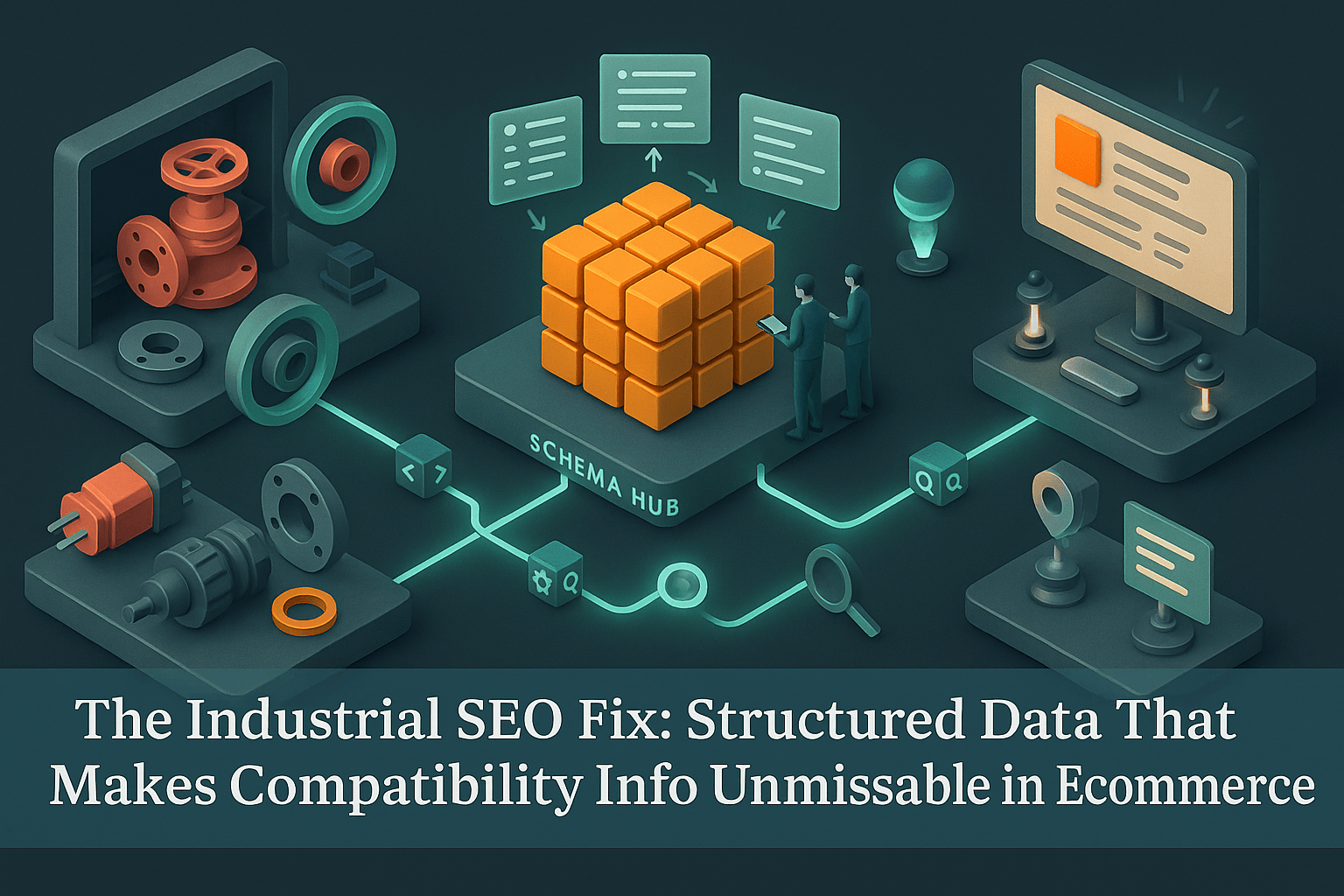The Invisible Product Problem
It usually starts with a phone call. A frustrated plant manager or procurement lead, voice tight, telling you they finally found the replacement part they’d been hunting for, only to realize your company never showed up in their search. And it’s not because you didn’t stock it. Or because your pricing was too high. Or because your sales team missed an email.
It’s because, in Google’s eyes, that part might as well not exist.
We’ve seen it firsthand. A supplier carried the exact OEM-certified component for a critical piece of heavy equipment—a perfect fit, factory-approved. The compatibility information was right there on the product page but buried in a bullet list and a PDF spec sheet. The human eye could read it in seconds. A search engine? Blind as a bat.
That’s the cruel irony in industrial eCommerce: you can have the part, the specs, the approvals, the photos… and still lose the sale before the buyer even knows you’re an option. Search engines don’t “see” compatibility the way we do. They need it structured, labeled, and machine-readable. Otherwise, all that detail sits locked inside your website like a library with no index.
In this business, industrial buyers don’t shop like consumers. They’re not typing “replacement pump” into Google. They’re searching by the machine they own—the model, the serial number, and the generation. If your page can’t wave back at those searches and say, Yes, we fit that, you’re invisible. And invisible means you’re not just missing out on one sale. You’re letting the aftermarket—the most profitable part of the industrial supply chain—pass you by, job after job, year after year.
That’s the problem structured data solves. It’s not about gaming the algorithm, it’s about speaking a language Google understands so your compatibility story gets told before your competitor’s does. And in a market where “who shows up first” is often “who gets the PO,” that translation can be worth millions.
How Industrial Buyers Actually Search for Compatibility
Walk into any procurement office or maintenance shop, and you’ll see it: the whiteboard scribbled with equipment model numbers, the dog-eared manuals, and the spreadsheet with every machine the facility runs. When an engineer or buyer needs a part, they don’t type in a poetic description. They search like a detective chasing a lead: manufacturer, model, series, and generation.
A typical query might be “CAT 3516B fuel injector” or “Allen-Bradley 1756-L73 firmware 32.011”. They’re not browsing categories or “similar items.” They’re looking for one thing: the exact part that matches their existing setup. If you serve the aftermarket, your biggest advantage is showing up at the moment of intent, not two pages later in “related products.”
Most industrial eCommerce sites do have that compatibility information, but it lives in formats Google can’t parse. A buyer might land on your site if they scroll through enough forums or click three layers deep into your navigation. But in search? You’re nowhere to be found.
And that’s because Google’s algorithms aren’t telepathic. They don’t “read” your PDFs. They don’t intuit that “works with Model X” means the same as “compatible with Model X.” They rely on structured data—schema markup that tells them, in their own language, exactly what your product fits, replaces, or upgrades.
When that data is missing, Google has to guess. And in the high-stakes game of compatibility, a guess is as good as silence. The buyer never sees you. They buy from the competitor who took the time to make their compatibility unmissable.
If you’ve ever wondered why you’re getting calls for parts you don’t stock but not for the ones you do, it’s probably not demand. It’s discoverability. And fixing it isn’t about adding more content; it’s about making the content you already have speak clearly to the machines that decide who gets seen first.
The Stakes of Being Missed in Compatibility Searches
When you sell industrial parts that hinge on compatibility, you’re not just competing for clicks, you’re competing for trust. A buyer searching for a replacement PLC card, pump seal, or servo motor isn’t exploring options for fun. They’re hunting for something that will work right the first time. If you don’t appear in that search, they assume you don’t have it. And in most cases, they’ll never double-check.
Here’s the real cost: every time you fail to show up for a compatibility-specific query, you’re losing a sale you were perfectly capable of fulfilling. These aren’t “low-intent” leads; they’re high-intent buyers with purchase orders ready. If you’re invisible in that moment, your aftermarket revenue bleeds into the hands of competitors who’ve made sure Google can read their product compatibility like an open book.
And because aftermarket sales are often the highest-margin transactions in industrial manufacturing, every missed search result is a direct hit to EBITDA. Unlike initial equipment sales, there’s no long sales cycle, no massive CapEx negotiation—just a buyer replacing what they already own. Lose enough of those, and you’re not just missing growth; you’re silently shrinking.
The danger isn’t only about today’s orders. Visibility in compatibility searches builds a silent loyalty loop. The buyer who finds you for a single part often comes back for more because you’ve proven two things:
- You stock what they need.
- You make it easy to confirm compatibility before they spend a dollar.
Break that loop, and the opposite happens. They start building a habit with your competitor. And habits, once formed, are brutally hard to break.
This is why structured data for compatibility isn’t a technical nice-to-have—it’s the infrastructure that determines whether you get called first… or not at all.
Why Compatibility Info Gets Lost in Translation Online
Most industrial eCommerce sites do have compatibility data. The problem is that it’s trapped—hidden inside product descriptions, PDF spec sheets, or worse, buried in “call for details” notes. A human engineer might scan the text and immediately know if a part fits, but to a search engine, it’s just a blob of unstructured words with no real meaning.
Google, Bing, and other search platforms don’t “understand” language the way humans do. They rely on structured cues to interpret relationships—signals that say this part fits this model or this component is certified for that standard. Without those signals, your product pages are like a conversation in a language search engines barely speak. They might catch a keyword or two, but the nuance—the actual fitment logic—never makes it into the index.
It’s not just about being invisible in the abstract. This is exactly why a competitor with a less complete catalog but better-structured data can outrank you for searches you should own. They’ve given Google the compatibility information in a machine-readable format through schema markup, linked data, or custom structured fields—so the engine can confidently connect “Model X pump” with “Seal Y” in milliseconds.
And the issue compounds in multi-market selling. If you’re serving both domestic and export buyers, compatibility rules often vary by region (different voltage standards, environmental certifications, or material compliance). If those distinctions aren’t clearly expressed in a structured way, search engines have no way to surface the right version of your product to the right buyer in the right geography.
The result? Missed opportunities, misdirected buyers, and more pre-sale engineering calls than you should need—just to clarify something that should have been clear before the buyer ever clicked “contact.”
Structured data doesn’t just fix this; it flips the script. It turns your compatibility info from a static blob of text into a dynamic, searchable, and understood asset that works for you 24/7.
Why Structured Data Matters for Compatibility SEO
Compatibility is the most valuable piece of product information you have—and the hardest for search engines to read. Without structure, it’s just a sentence in a description or a line in a PDF. A human can understand it instantly; Google can’t. That gap is why buyers who search for the exact model you support might never see your product at all.
Structured data closes that gap. Using Schema.org properties like isRelatedTo, isAccessoryOrSparePartFor, hasProductModel, and productionDate, you can translate your compatibility logic into a language search engines actually understand. This means you’re not just saying “fits Model X” in a paragraph—you’re explicitly declaring this part is compatible with Model X manufactured between 2018–2022 in the North American market. There’s no guesswork, no chance the detail gets lost in parsing.
This precision also extends across markets. Voltage standards, material compliance, and certification rules often change by region. Structured data lets you tag compatibility conditions by geography, so a buyer in Germany sees only EU-compliant parts, while a U.S. buyer sees UL-listed equivalents—without you managing separate product pages for each.
One critical nuance: structured data alone won’t make you rank #1. It improves eligibility for high-intent, compatibility-driven queries, but it works best alongside core SEO foundations like crawlability, fast load times, and authority signals. And for complex catalogs, you can’t maintain this by hand. Most industrial suppliers who scale compatibility markup successfully do it by pulling live data from their ERP, PIM, or PLM and generating markup dynamically—so it updates instantly when specs change, products are retired, or compliance rules shift.
When done right, structured data doesn’t just improve rankings; it shifts what you rank for. You stop competing for broad, low-intent queries and start owning the hyper-specific searches that come with a purchase order attached. That’s not just SEO. That’s turning your engineering truth into discoverable, revenue-driving proof, on every product, in every market, 24/7.
Structured Data as the Compatibility Translator
Think of structured data as the interpreter in the room when you’re trying to explain complex compatibility rules to someone who doesn’t speak your language. Without it, search engines hear your product page the way a tourist hears rapid-fire local slang, picking out a few familiar words but missing the meaning entirely.
Structured data, whether implemented through Schema.org markup, JSON-LD, or microdata, gives search engines a clear, standardized way to “read” and “file” your compatibility information. It doesn’t guess that a given motor fits a specific gearbox—it knows, because you’ve told it in a format it can parse instantly.
And here’s where it changes the game for industrial parts suppliers:
Precision fitment mapping, you can explicitly define relationships like Part A is compatible with Models X, Y, and Z manufactured between 2015–2022, or Only fits with Adapter Q in EU installations.
Multi-market intelligence, if voltage or compliance rules vary by geography, structured data can tag compatibility by region. That way, a buyer in Germany sees only the products that pass EU regulations, while a U.S. buyer sees UL-compliant equivalents.
Dynamic search enhancement, when structured data is applied consistently, it feeds directly into rich search results—think product listings that already show compatible models before the buyer even clicks. That’s not just visibility—it’s pre-qualified visibility.
In a world where B2B buyers do the majority of research before ever contacting a supplier, structured data makes sure your compatibility logic is visible at the decision-making stage, not buried in a PDF three clicks deep. If you’re selling compatibility-dependent products, structured data isn’t just SEO—it’s the connective tissue between your engineering reality and your digital storefront’s discoverability. Without it, you’re leaving fitment clarity—and the sales that depend on it—up to chance.
Where Most Industrial Sites Go Wrong With Structured Data
Walk through enough industrial e-commerce sites and you start seeing the same patterns—the same mistakes that quietly sabotage compatibility visibility, even when the company thinks they’ve “done SEO.”
The first mistake is treating compatibility like marketing fluff instead of engineering truth.
Some sites toss fitment info into a product description as a sentence or two, maybe copied from a spec sheet. It’s fine for a human skimming the page, but to a search engine it’s just text in a paragraph, buried alongside adjectives and sales copy. There’s no way for Google to extract that as structured compatibility data—and so it doesn’t.
The second is siloed product data.
Compatibility lives in a dozen different places: engineering databases, PDFs, printed manuals, and an old Excel sheet in someone’s downloads folder. Instead of consolidating it into one clean, structured format, teams copy and paste fragments into product listings. The result? Inconsistent formats, conflicting details, and markup that’s impossible to maintain.
The third is “schema by checkbox.”
Plenty of platforms and SEO plugins promise structured data with a quick toggle or template. But generic markup isn’t enough for complex compatibility rules. If you sell a hydraulic pump that only works with specific valve assemblies, the default schema template won’t capture that nuance. Without custom properties, you’re signaling “this is a pump,” but not “this is the pump that fits Model X and Y built after 2019.”
The fourth is outdated or incomplete markup.
Compatibility changes over time; new models, new standards, and discontinued parts. If your structured data isn’t updated alongside your catalog, you’re effectively telling search engines the wrong story. In an industrial context, that can mean a customer finds you for a product that no longer fits their system, leading to a wasted lead or worse, a returned order.
These aren’t minor oversights; they’re the digital equivalent of mislabeling a part bin in your warehouse. And just like in the physical world, a mislabeled bin doesn’t just waste someone’s time, it erodes trust.
The fix starts with owning the fact that structured data isn’t an afterthought; it’s part of the product itself. If compatibility is core to what you sell, it has to be core to how your site communicates with search engines. Without that shift, you’re just hoping Google does the hard work of figuring it out—and hoping is not a strategy.
Engineering Compatibility Into Your Structured Data
If structured data is the language you use to talk to search engines, compatibility details are your technical dialect—the precision terms, relationships, and constraints that make your products different from the generic parts next door. And just like a dialect, you can’t fake fluency; you have to actually understand the rules and express them consistently.
Start With a Single Source of Truth
The first step isn’t writing JSON-LD—it’s deciding where compatibility lives inside your organization. Is it in your ERP? Your PLM? A specialized fitment database? If it’s scattered across PDFs, emails, and tribal knowledge in your engineering team, you’ll never be able to feed accurate, structured data to your site. Centralize it. Treat compatibility data like inventory—version-controlled, validated, and accessible.
Map Real-World Relationships to Schema Markup
Search engines can only “see” relationships you explicitly declare. If Part A only fits Machine Models 401, 402, and 403 manufactured after 2018, that has to be expressed in structured data, not buried in a bullet list on the page. This means working with schema.org’s isRelatedTo, hasProductModel, productionDate, and even custom properties when standard ones fall short. The goal is to tell Google exactly what fits what, in a machine-readable way, so there’s zero guesswork.
Handle Exceptions Like a Pro
Compatibility is rarely absolute. A component might fit if a certain adapter is used or only in certain voltage ranges. This is where most sites throw their hands up and dump a vague note into the description. Instead, encode these conditional relationships in a way that both your site logic and your markup can reflect. Yes, it’s harder. But when Google understands conditional compatibility, you show up for searches competitors miss—because their data is too blunt to make the match.
Keep It Live, Not Static
Compatibility data changes; new product lines, updated safety standards, and discontinued SKUs. Your structured data needs to be tied to the same source your sales and engineering teams trust, so updates are automatic. If your schema markup is hard-coded into templates, you’re creating a maintenance nightmare. Instead, generate it dynamically from your centralized database, so the minute a compatibility rule changes, it’s reflected in every page and every search engine crawl.
Test, Audit, Iterate
Even well-planned structured data can fail silently—missing relationships, syntax errors, or logic gaps that keep search engines from connecting the dots. Use Google’s Rich Results Test and Search Console, but don’t stop there. Run spot checks comparing your compatibility markup against actual search queries you want to win. If Google still isn’t matching you to the right searches, something in your structure isn’t clear enough.
When you engineer compatibility into your structured data like this, you stop playing defense. Instead of hoping search engines “get it,” you’re feeding them a blueprint they can follow to the letter. That’s when you start showing up for the searches that matter most—the ones buyers run when they’re deep in the decision phase and looking for the exact fit you sell.
From Invisible to Indispensable — How Structured Compatibility Changes Buyer Behavior
When compatibility data is buried in a PDF or scattered across spec sheets, you force buyers to work for the answer. They might email sales, call customer service, or worst of all—leave your site to hunt down the info somewhere else. Every one of those moments is a chance to lose the sale.
But when you make compatibility unmissable—baked right into the product page and mirrored perfectly in the structured data—something changes. You’re not just answering a question; you’re removing doubt before it even forms.
Shaping Trust at the First Click
Imagine a maintenance manager searching for a replacement part at 10 p.m., halfway across the world from your headquarters. They type in the machine model and the year of manufacture. Instead of scrolling through a dozen irrelevant results, they see your listing at the top—complete with a search snippet that explicitly says, “Compatible with Model X (2015–2019).” They don’t have to guess, click, or compare. You’ve already told them you have the right fit.
In industries where downtime is measured in thousands of dollars per hour, that kind of clarity doesn’t just win clicks—it wins loyalty. Once they’ve experienced that level of certainty, they remember it. And the next time they need something, they start with you.
Turning SEO Into a Sales Accelerator
Good structured data doesn’t just improve rankings—it changes what you rank for. Without compatibility markup, you compete for broad, generic searches where you’re one of hundreds of options. With it, you show up for high-intent searches—queries so specific they practically shout, “I’m ready to buy.”
That shift shortens the sales cycle. Buyers who land on your page already believe the part will work, so the conversation moves from if to how soon can you ship? It’s the difference between spending two weeks convincing them you’re right and closing the deal on the first call.
Feeding Every Channel, Not Just Search
There’s another ripple effect most teams don’t see coming: when compatibility is properly structured, it’s reusable across every channel. Your CPQ system can pull it into quotes. Your ecommerce platform can filter results automatically. Your service reps can confirm fits instantly, without digging through manuals.
And because it’s all tied back to one source of truth, the answer is always the same—whether the buyer’s talking to Google, your sales team, or your chatbot. That consistency is what makes a brand feel dependable, especially in industries where a single wrong part can mean weeks of delay.
When you do this right, compatibility stops being a line item buried in technical docs. It becomes part of your value proposition—a quiet, constant promise that you’ll get it right the first time. And that’s the kind of promise buyers don’t forget.
Implementation Without the Headaches — Rolling Out Structured Compatibility Data
Rolling out structured compatibility data doesn’t have to mean pulling your entire product catalog apart and starting from scratch. The real trick is avoiding disruption—making the shift without freezing your sales pipeline or dumping extra work on engineering. That’s where most companies fail: they try to “big bang” it, flipping the switch all at once, and chaos follows.
Start Where the Money Is
You don’t need to tag every product on day one. Start with the high-volume SKUs and high-margin parts that make the most impact. Those are usually the items with the most compatibility questions—the ones clogging your support lines or slowing down quotes. Fix those first, and you’ll see measurable results before you even touch the rest of the catalog.
Let Sales and Support Drive the Rules
The best compatibility data doesn’t come from a spreadsheet; it comes from the people who answer the same fitment question fifty times a week. Pull sales reps, customer service teams, and field engineers into the process early. They’ll tell you where buyers get stuck, what’s misunderstood, and which compatibility mistakes cause the biggest headaches. That’s the intel you build your structured data rules around.
Integrate With, Don’t Replace
Your ERP, PIM, and e-commerce platform already hold pieces of the puzzle—use them. Instead of creating a new standalone database, layer structured data on top of what you’ve got. Pull from existing “truth” sources so the compatibility info on your website, in Google, and in your quoting tools is always consistent.
Test in a Sandbox, Not on Live Pages
Don’t gamble with your live traffic. Spin up a test environment where you can apply structured compatibility data to a few products, then validate two things:
- Search engines are reading it correctly
- Buyers are responding the way you want (higher click-throughs, fewer compatibility inquiries).
Only then do you push to production—and even then, in batches.
Keep It Living
Compatibility isn’t a one-and-done job. Products get updated, regulations shift, and suppliers change specs. If you treat structured data like a static project, it will go stale, and stale data kills trust. Build a process for regular reviews, whether that’s quarterly audits or automatic updates from your PIM.
When you roll it out with this kind of care, you avoid the nightmare scenario—angry buyers, broken search listings, and an overwhelmed team—and instead get exactly what you’re aiming for: a smooth transition that pays for itself before you’re even done implementing.
Turning Compatibility Data Into a Competitive Moat
Structured compatibility data isn’t just about getting a rich snippet in Google or answering fewer “will this fit?” emails. Done right, it becomes part of your competitive moat, a subtle but powerful reason buyers come back to you instead of wandering off to a competitor.
Think about it: in industrial parts sales, trust is earned in inches. A buyer who finds exactly what they need on the first try is far more likely to order again, order faster, and order more. The flip side is brutal; one compatibility mistake, and they remember you for the wrong reason. Structured data, when maintained and integrated properly, ensures you’re always on the right side of that equation.
It also changes how your products show up in search. Instead of competing purely on brand name or SKU-level keywords, you start showing up for the hyper-specific, high-intent queries that signal a ready-to-buy customer. Those clicks aren’t “maybe someday” traffic; they’re purchase orders in the making.
The moat gets even deeper when you think beyond the initial sale. If your portal or product pages continually serve up precise compatibility matches, based on serial numbers, equipment models, or past orders, you’re reducing friction in the repeat buying process. That’s where margin lives in the aftermarket, and it’s where competitors without this data will bleed time and trust trying to catch up.
This isn’t a marketing gimmick; it’s operational discipline turned outward. And because the system requires real integration between your catalog, your technical specs, and your web presence, it’s not something a competitor can copy with a weekend SEO project. It takes commitment. Which is exactly why it works.
Compatibility Structured Data Toolkit
Compatibility Visibility Audit Checklist
Run this audit before doing any coding. Go through your current product catalog and mark each item based on whether compatibility info is visible, machine-readable, and consistent. This gives you the “map” of what’s broken before you start fixing.
| Checkpoint | Why It Matters | Status (☑/☐) |
| Compatibility info present on all product pages | If it’s missing for even one SKU, that SKU will never show in compatibility searches | ☐ |
| Compatibility info visible in HTML (not just PDFs/images) | Search engines can’t parse text in PDFs or images | ☐ |
| Compatibility terms consistent (e.g., “fits Model X” vs “compatible with Model X”) | Inconsistent phrasing confuses both buyers and search engines | ☐ |
| Region-specific compatibility listed clearly | Prevents compliance errors and wrong-market results | ☐ |
| No duplicate/conflicting compatibility claims across site | Conflicts erode trust and ranking signals | ☐ |
Structured Data Build Checklist
Treat this like your technical scope. Share with your dev/SEO team and check off each property as it’s implemented and validated in Google’s Rich Results Test.
| Property / Action | Purpose | Build Status |
| isRelatedTo relationships | Explicitly link product to compatible models | ☐ |
| isAccessoryOrSparePartFor for spares & upgrades | Tells search engines this product is a direct accessory or spare | ☐ |
| hasProductModel with model number detail | Strengthens matching for model-specific searches | ☐ |
| Conditional compatibility encoding (e.g., voltage, adapter needed) | Let’s Google match you for complex “if/only if” queries | ☐ |
| Region tags for compatibility (geo-specific) | Ensures correct SKUs show to correct markets | ☐ |
| Dynamic markup generation from ERP/PIM/PLM | Keeps compatibility data live & accurate | ☐ |
| JSON-LD format validation | Ensures Google can parse without errors | ☐ |
Dynamic Schema Implementation Planner
Purpose: Plan how to keep compatibility markup live, not static.
How to Use: Assign an owner for each feed and confirm automation approach.
| Data Source | Data Owner | Update Frequency | Integration Method | Status |
| ERP Inventory & Specs | Ops/IT | Real-time | API | |
| PLM Compatibility Rules | Engineering | Weekly | API / Data Export | |
| Compliance DB | Compliance Officer | Real-time | API | |
| PIM Product Attributes | Marketing/IT | Weekly | Sync Script |
Pre-Launch Testing Sequence
Follow in order, record pass/fail, fix before launch.
| Step | Tool / Method | Pass / Fail | Notes |
| Validate JSON-LD syntax | Google Rich Results Test | ||
| Confirm schema matches live page content | Manual Review | ||
| Search target model numbers in Google, see if snippet shows compatibility | Live SERP Test | ||
| Test region-specific queries with VPN | Live SERP Test |
Post-Launch ROI & Impact Dashboard
Record baseline before launch, track monthly after launch.
| Metric | Baseline | Month 1 | Month 3 | Month 6 | Target |
| Visibility for model-specific queries | X% | +50% | |||
| CTR from compatibility searches | X% | +20% | |||
| Orders from compatibility queries | $X | +25% | |||
| Wrong part returns | X% | -80% | |||
| “Will this fit?” pre-sale calls | X/month | -60% |
Stop Hiding Your Best Advantage in a Spreadsheet
Every day you run without structured, visible compatibility data, you’re training your customers to look elsewhere when they need answers. They’ll find the info, and when they do, that sale is gone.
The thing is, you already have the knowledge. Your engineers, your catalogs, your service teams—they’ve been living with this data for years. The gap isn’t know-how—it’s delivery. Search engines can’t see it. Buyers can’t trust it. And you can’t measure the deals you’ve lost because of it.
We can fix that. In weeks, not quarters. We’ll help you surface every compatibility rule, every model number, and every nuance of “will it fit?” in a way Google loves and customers understand instantly. The result isn’t just better SEO; it’s fewer support calls, more repeat orders, and a reputation for “getting it right” every single time.
If you’re ready to stop bleeding margin on preventable questions and missed clicks, let’s build the blueprint. No boilerplate. No guesswork. Just a compatibility engine your competitors can’t touch. Contact us, and we’ll show you exactly how it can work for your catalog, your systems, and your market—before someone else beats you to it.
















